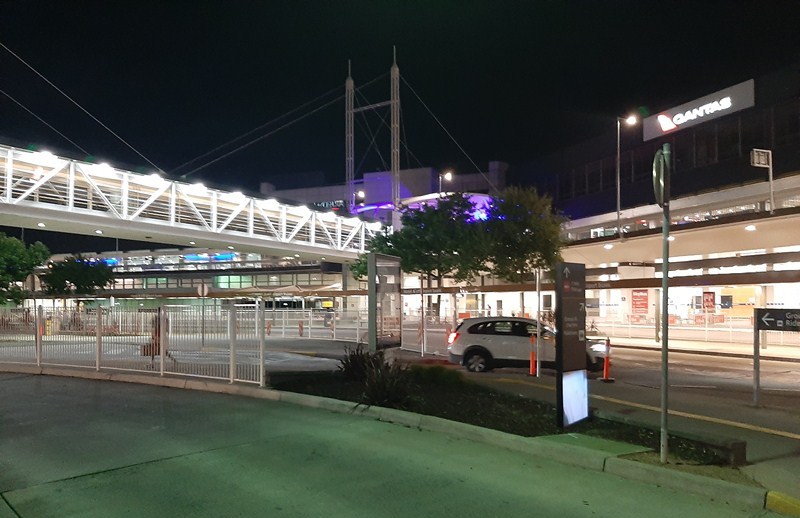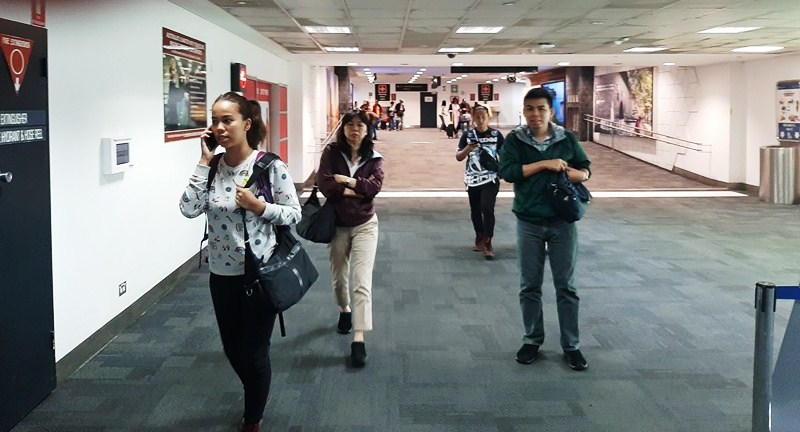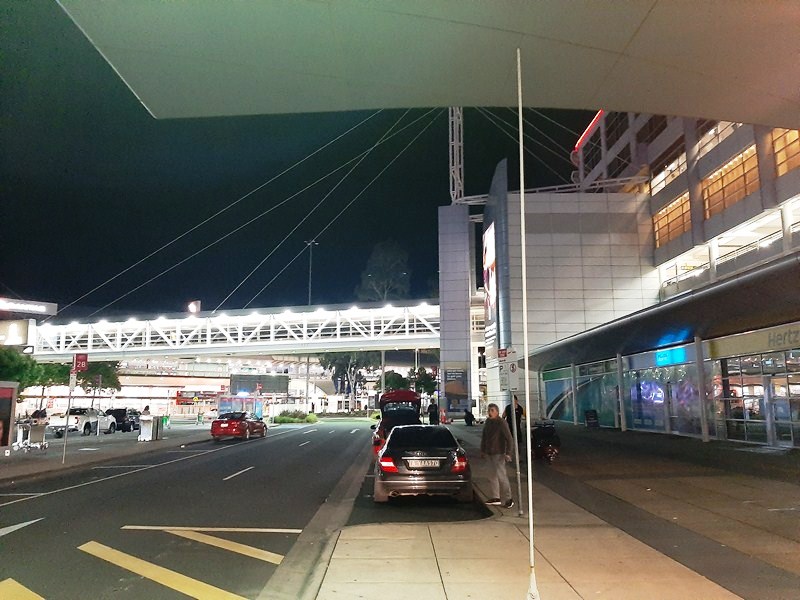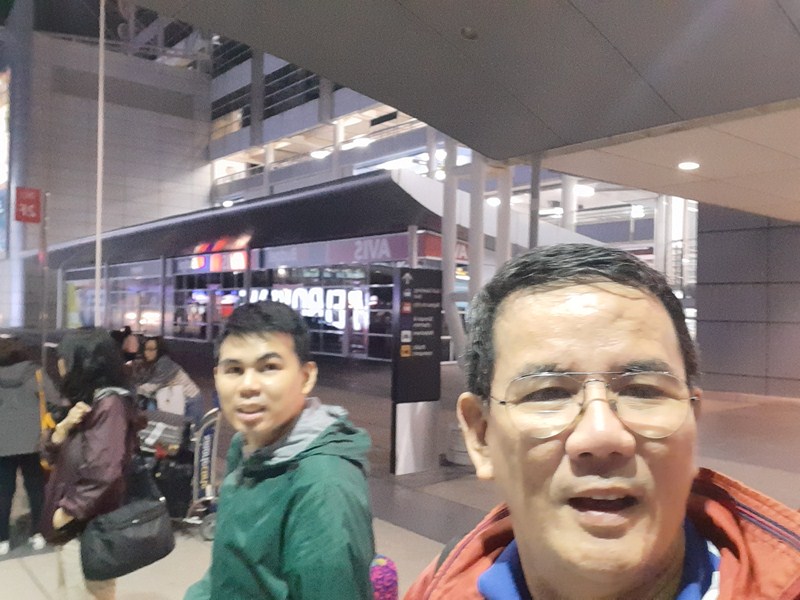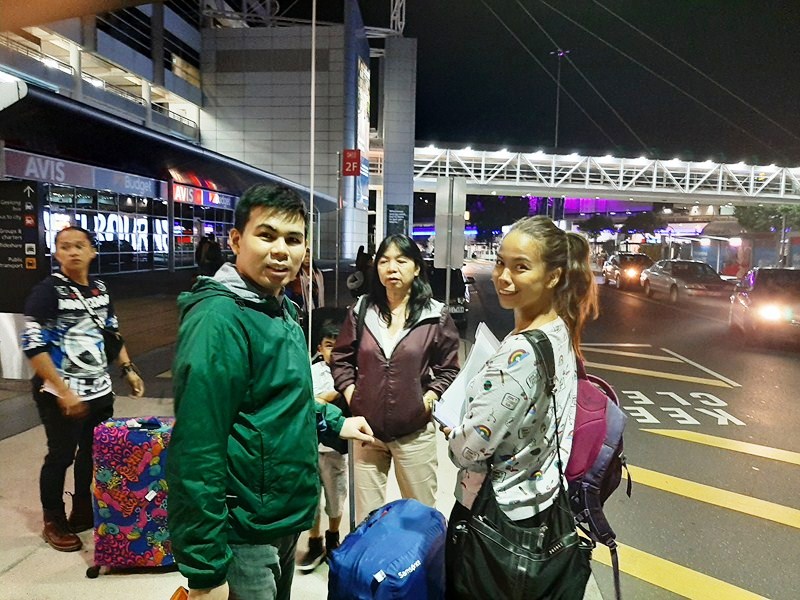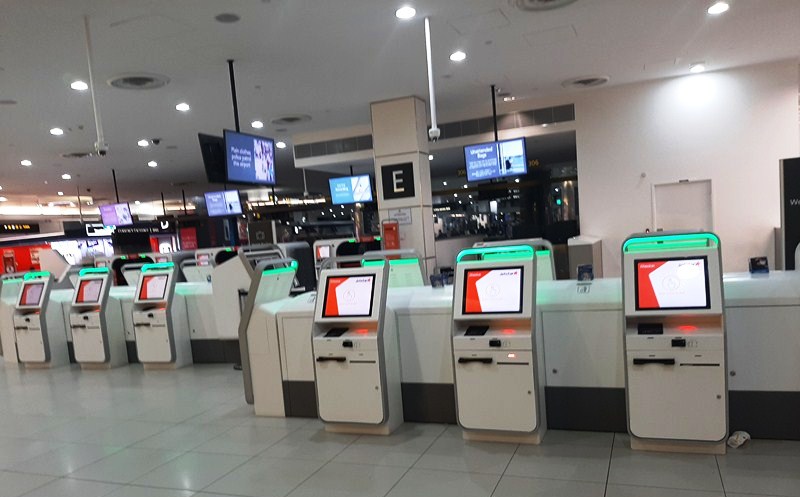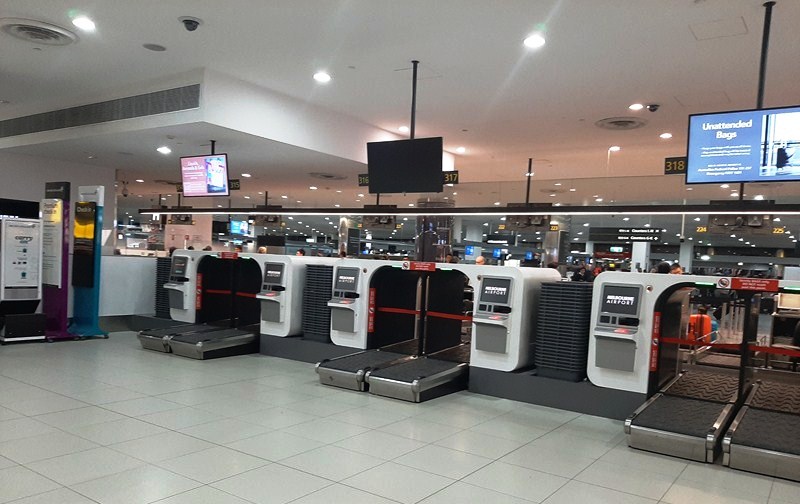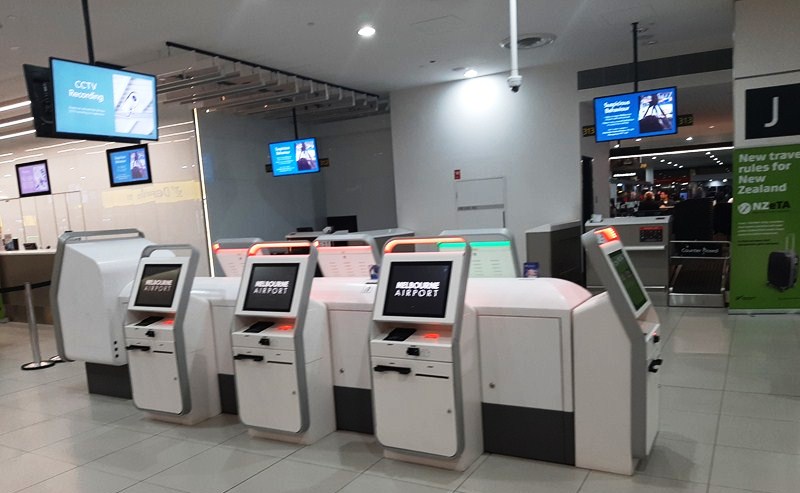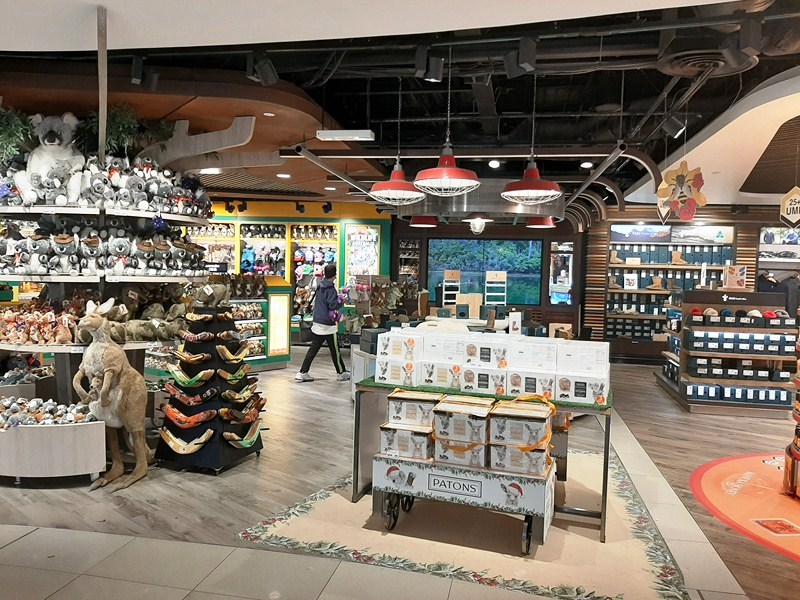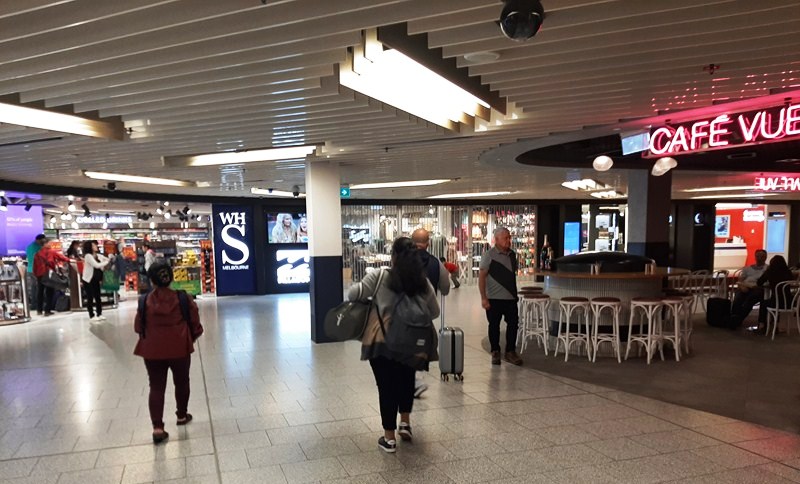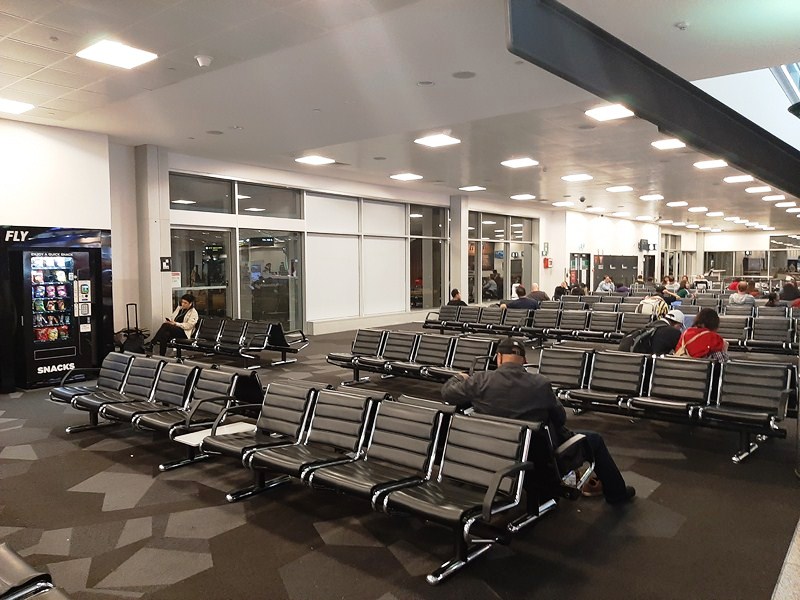Our gateway for our week long visit to Melbourne was to be Melbourne Airport (IATA: MEL, ICAO: YMML), colloquially known as Tullamarine Airport. After an 8-hour, non-stop flight from NAIA Terminal 3, it was almost midnight when our Cebu Pacific Airbus A321 plane landed in this airport’s Terminal 2 (one of the airports four terminals) which handles all international, and limited domestic, flights out of Melbourne Airport.
The terminal has 20 gates with aero bridges. On arrival, we streamed on to the first floor to connect with the current first floor arrivals deck. Departures take place on the lower deck (similar to the A380 boarding lounges currently in use at Gates 9 and 11). All gates, including 18 and 20, are now handling passengers.
Cathay Pacific, Malaysia Airlines, Qantas, Singapore Airlines, Air New Zealand and Emirates all operate airline lounges in this terminal. The terminal contains works by noted Australian Indigenous artists including Daisy Jugadai Napaltjarri and Gloria Petyarre.
Here are some interesting trivia regarding this international airport:
- It is the primary airport serving the city of Melbourne
- Melbourne is the second busiest airport in Australia for passenger movements, behind Sydney and ahead of Brisbane.
- It opened in 1970 to replace the nearby Essendon Airport (which was officially designated an international airport in 1950).
- Melbourne Airport is the main international airport of the four airports serving the Melbourne metropolitan area, the other international airport being Avalon Airport.
- The airport comprises four terminals: one international terminal, two domestic terminals and one budget domestic terminal.
- The airport has its own suburb and postcode—Melbourne Airport, Victoria (postcode 3045).
- In 2016-17, Melbourne Airport recorded around 25 million domestic passenger movements and around 10 million international passenger movements. In that year there were 239,466 aircraft movements in total.
- The Melbourne–Sydney air route is the third most-traveled passenger air route in the world.
- The airport features direct flights to 33 domestic destinations and to destinations in the Pacific, Europe, Asia, North America and South America.
- Melbourne Airport is the number one arrival/departure point for the airports of four of Australia’s eight other capital cities.
- Melbourne serves as a major hub for Qantas and Virgin Australia, while Jetstar Airways and Tigerair Australia utilize the airport as home base.
- Domestically, Melbourne serves as headquarters for Australian airExpress and Toll Priority and handles more domestic freight than any other airport in the nation.
- Melbourne Airport, originally called Melbourne International Airport, is commonly referred to as Tullamarine or simply as Tulla to distinguish the airport from the other three Melbourne airports: Avalon, Essendon and Moorabbin.
- Tullamarine is a name derived from the indigenous name Tullamareena.
- Melbourne Airport is categorized as a Leased Commonwealth Airport.
- The airport was the first in Australia to be capable of handling the A380.
- It the first airport in Australia to receive, in 2004, an ISO 14001 accreditation, the world’s best practice standard.
- The Melbourne FIR center controls 6% of the world’s airspace (Victoria, Tasmania, southern New South Wales, most of South Australia, the southern half of Western Australia and airspace over the Indian and Southern Ocean).
- The airport is the home of the Canberra, Adelaide and Melbourne approach facilities, which provide control services to aircraft arriving and departing at those airports.
- The airport is curfew-free and operates 24 hours a day (although, between 2 AM and 4 AM, freight aircraft are more prevalent than passenger flights).
Here’s the historical timeline of the airport:
- In February 1958, the search for a replacement for Essendon commenced when a panel was appointed to assess Melbourne’s civil aviation needs.
- In 1959, the Commonwealth Government acquired 5,300 ha. (13,000 acres) of grassland in then-rural Tullamarine.
- In May 1959 it was announced that a new airport would be built at Tullamarine
- On November 27, 1962, Prime Minister Robert Menzies announced a five-year plan to provide Melbourne with a A$45 million “jetport” by 1967.
- In November 1964, the first sod at Tullamarine was turned. In line with the five-year plan, the runways at Essendon were expanded to handle larger aircraft
- In October 1964, Ansett Australia launched the Boeing 727 there, the first jet aircraft used for domestic air travel in Australia.
- On July 1, 1970, Prime Minister John Gorton opened Melbourne Airport to international operations ending Essendon’s near two decade run as Melbourne’s international airport. Essendon still was home to domestic flights for one year. On opening, Melbourne Airport consisted of three connected terminals: International in the centre, with Ansett to the South and Trans Australia Airlines to the North. The design capacity of the airport was eight Boeing 707s at a rate of 500 passengers per hour.
- On June 26, 1971, Essendon’s airport operations was transferred to Melbourne Airport with the first arrival of a Boeing 747 occurring later that year. In the first year of operations, Melbourne handled six international airlines and 155,275 international passengers.
- In 1973, minor expansion works was completed allowing Boeing 747s to serve the airport.
- By the late 1980s, peak passenger flows at the airport had reached 900 per hour, causing major congestion.
- In 1988, the Australian Government formed the Federal Airports Corporation(FAC), placing Melbourne Airport under the operational control of the new corporation along with 21 other airports around the nation.
- In 1989, expansion of the Ansett domestic terminal was approved
- In 1991, the expansion was completed with the addition of a second pier for use by smaller regional airlines.
- In 1991, work on an upgrade of the international terminal commenced.
- In 1992, Terminal 1 passed to Qantas when it acquired Trans Australia Airlines.
- In late 1993, the ‘SkyPlaza’ retail complex was completed on a site flanking the main international departure gates.
- In April 1994, the Australian Government announced that all airports operated by FAC would be privatized in several phases.Melbourne Airport was included in the first phase, being acquired by the newly formed Australia Pacific Airports Corporation Limited for $1.3 billion.
- Between 1995 and August 1997, the multi-storey carpark outside the terminal was completed at a cost of $49 million, providing 3,100 parking spaces, the majority undercover. This initially four-level structure replaced the previous open air car park outside the terminal.
- On June 30, 1997, the transfer was completed on a 50-year long-term lease, with the option for a further 49 years.
- In 1995, the new three-level satellite concourse was opened at the end of the existing concourse. Diamond shaped and measuring 80 m. (260 ft.) on each side, the additional 10 aerobridges provided by the expansion doubled the international passenger handing capacity at Melbourne Airport.
- In October 1997, improvements on the original Terminal 1 commenced.
- In January 1999, work commenced on the six-storey, 276-room Hilton Hotel (now Park Royal) above the car park
- In late 1999, improvements on the Qantas domestic terminal (Terminal 1), featuring a second pier, stands for 9 additional aircraft, an extended access roadway and the expansion of the terminal, was completed at a cost of $50 million.
- In mid-2000, the Hilton Hotel was completed at a cost of $55 million.
- In December 2000, the Domestic Express Terminal (the first passenger terminal facility to be built at Melbourne Airport since 1971), located to the south of the main terminal building and built at a cost of $9 million, was opened.
- In 2004, revenue from retail operations at Melbourne Airport broke the $100 million mark for the first time this being a 100% increase in revenue since the first year of privatization.
- In 2004, the expansion of car parks continued with a $40 million project commenced, doubling the size of the short term carpark with the addition of 2,500 spaces over six levels, along with 1,200 new spaces added to the 5,000 already available in the long term car park.
- In 2005, the airport undertook construction works to prepare the airport for the arrival of the double-decker Airbus A380. The main work was the widening of the main north–south runway by 15 m. (49 ft.)
- In May 2005, over a 29-day period, the improvements were completed. It included the construction of dual air bridges (Gates 9 and 11) with the ability to board both decks simultaneously to reduce turnaround times, the extension of the international terminal building by 20 m. (66 ft.) to include new penthouse airline lounges, and the construction of an additional baggage carousel in the arrivals hall.
- On June 5, 2008, it was announced that the airport would install a Category III landing system (the first of its kind in Australia), allowing planes to land in low visibility conditions, such as fog.
- In July 2005, the current terminal numbering system was introduced. Previously, they were known as Qantas Domestic, International and South (formerly Ansett Domestic).
- On November 14, 2005, the A380 made its first test flight into the airport.
- In March 2006, the airport undertook a 5,000 sq. m. (54,000 sq. ft.) expansion of Terminal 2, and the construction of an additional level of airline lounges above the terminal.
- In June 2007, a A$5 million refit for Terminal 4 began along the lines of the budget terminal model at Singapore Changi Airport and Kuala Lumpur International Airport.
- In 2008, a further 25,000 sq. m. (270,000 sq. ft.) expansion of Terminal 2 commenced, costing $330 million.
- On November 23, 2007, Tiger Airways Australia operated its first domestic flight at Terminal 4.
- On May 15, 2008, the A380 made its first passenger flight into the airport when a Singapore Airlines Sydney-bound flight was diverted from Sydney Airport because of fog.
- Beginning in October 2008, Qantas became the first airline to operate the A380 from the airport, flying nonstop to Los Angeles International Airport twice a week. This was the inaugural route for the Qantas A380.
- On March 2010, the new, $10 million Category III landing system was commissioned.
- In 2011, the expansion of Terminal 2, adding 5 additional aero bridges on a new passenger concourse, and a new 5,000 sq. m. (54,000 sq. ft.) outbound passenger security and customs processing zone, was completed.
- In March 2012, airport officials broke ground for the expansion of Terminal 4 facilities to accommodate Tiger Airways Australia and Jetstar Airways flights
- On August 18, 2015, the new Terminal 4 was opened.
- In November 2015, Jetstar moved into Terminal 4.
Melbourne Airport’s terminals have 53 domestic and 15 international gates plus five dedicated freighter parking positions (which host 21 dedicated freighter operations a week) on the Southern Freighter Apron. This airport is located 23 kms. (14 mi.) northwest of the city centre, adjacent to the suburb of Tullamarine, and is accessible via the Tullamarine Freeway.
Terminal 1, hosting domestic and regional services for Qantas Group airlines, Qantas and QantasLink (which is located to the northern end of the building), has a Qantas Club, Business Class and a chairman’s lounge; a wide range of shops and food outlets (situated at the end of the terminal near the entrance into Terminal 2); 16 parking bays served by aero bridges (12 are served by single aero bridges whilst four are served by double aero bridges); and five non-aero bridge gates (used by QantasLink).Departures are located on the first floor, while arrivals are located on the ground floor.
Terminal 3 opened with the airport as the Ansett Australia terminal, is now owned by Melbourne Airport. Terminal 3 is home to Virgin Australia (three gates are dedicated to it) and has eleven parking bays served by single aero bridges and eight parking bays not equipped with aero bridges.
Terminal 4, originally called the Domestic Express or South Terminal, was originally constructed for Virgin Blue (formerly Virgin Australia, it eventually moved into Terminal 3 following the demise of Ansett) and Impulse Airlines. It is dedicated to budget airlines and is the first facility of its kind at a conventional airport in Australia.
Due to the basic facilities, lack of jet bridges, and fewer amenities and retail outlets compared to a conventional terminal, lower landing and airport handling fees are charged to airlines. Unlike in Singapore and Kuala Lumpur, however, this terminal is located next to the main terminal building. The new, 35,000 sq. m. (380,000 sq. ft.) Terminal 4, currently used by Tigerair Australia, Regional Express Airlines, Jetstar (now has triple the number of gates it had at Terminal 1) and Airnorth, is and linked “under one roof” with Terminal 3.
This airport has won national and state tourism awards namely:
- In 1997 and 1998, the International Air Transport Association ranked Melbourne among the top five airports in the world.
- In 2002 and 2004, respectively, Singapore Airlines presented the airport with the Service Partner Award and Premier Business Partner Award.
- In 2003, Melbourne received the IATA’s Eagle Award for service and two National Tourism Awards for tourism services.
- In 2006, the airport won the Australian Construction Achievement Award for the runway widening project (dubbed “the most outstanding example of construction excellence for 2006”).
- In 2012, Parkroyal Melbourne Airport was awarded by Skytrax for the best airport hotel in Australia/the Pacific. According to Skytrax World’s Top 100 Airports List, Melbourne Airport has improved from ranked 43rd in 2012 to 27th in 2018.
Melbourne Airport has two intersecting runways: one 3,657 m (11,998 ft) north–south and one 2,286 m (7,500 ft) east–west. In addition to the onsite control tower, the airport is home to Melbourne Center, an air traffic control facility that is responsible for the separation of aircraft in Australia’s busiest flight information region (FIR), Melbourne FIR.
One freeway off ramp runs directly into the airport grounds, and a second to the south serves freight transport, taxis, buses and airport staff. It also has five car parks, all of which operate 24 hours a day, 7 days a week. As of 2019, there is no railway connection between the airport and the city.
Melbourne Airport is served by four hotels – the six-storey, 280-room Parkroyal Hotel (originally a Hilton but relaunched as the Parkroyal on April 4, 2011), located 100 m. (330 ft.) from Terminal 2 atop the multi-level carpark; Holiday Inn, located 400 m. (1,300 ft.) from the terminal precinct; Ibis Budget, located 600 m. (2,000 ft.) from the terminals; and Mantra Tullamarine, located 2 kms. (1.2 mi.) from the terminal precinct.
Melbourne Airport: Victoria 3045, Australia. Tel: +61 3 9297 1600. Website: www.melbourneairport.com.au.

